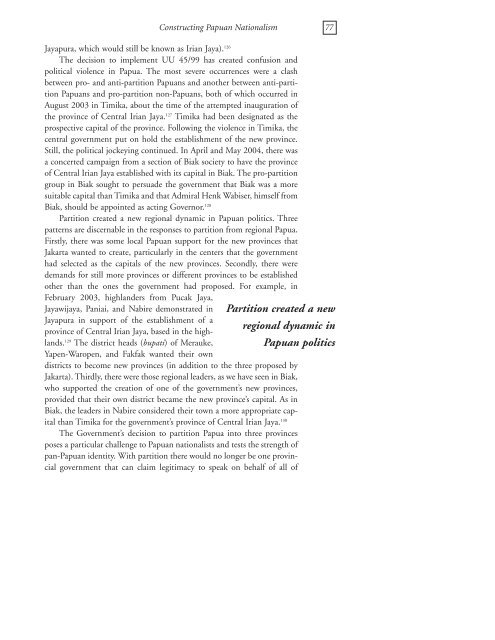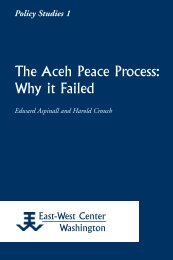Constructing Papuan Nationalism: History, Ethnicity ... - ScholarSpace
Constructing Papuan Nationalism: History, Ethnicity ... - ScholarSpace
Constructing Papuan Nationalism: History, Ethnicity ... - ScholarSpace
- No tags were found...
Create successful ePaper yourself
Turn your PDF publications into a flip-book with our unique Google optimized e-Paper software.
<strong>Constructing</strong> <strong>Papuan</strong> <strong>Nationalism</strong> 77Jayapura, which would still be known as Irian Jaya). 126The decision to implement UU 45/99 has created confusion andpolitical violence in Papua. The most severe occurrences were a clashbetween pro- and anti-partition <strong>Papuan</strong>s and another between anti-partition<strong>Papuan</strong>s and pro-partition non-<strong>Papuan</strong>s, both of which occurred inAugust 2003 in Timika, about the time of the attempted inauguration ofthe province of Central Irian Jaya. 127 Timika had been designated as theprospective capital of the province. Following the violence in Timika, thecentral government put on hold the establishment of the new province.Still, the political jockeying continued. In April and May 2004, there wasa concerted campaign from a section of Biak society to have the provinceof Central Irian Jaya established with its capital in Biak. The pro-partitiongroup in Biak sought to persuade the government that Biak was a moresuitable capital than Timika and that Admiral Henk Wabiser, himself fromBiak, should be appointed as acting Governor. 128Partition created a new regional dynamic in <strong>Papuan</strong> politics. Threepatterns are discernable in the responses to partition from regional Papua.Firstly, there was some local <strong>Papuan</strong> support for the new provinces thatJakarta wanted to create, particularly in the centers that the governmenthad selected as the capitals of the new provinces. Secondly, there weredemands for still more provinces or different provinces to be establishedother than the ones the government had proposed. For example, inFebruary 2003, highlanders from Pucak Jaya,Jayawijaya, Paniai, and Nabire demonstrated inJayapura in support of the establishment of aprovince of Central Irian Jaya, based in the highlands.129 The district heads (bupati) of Merauke,Yapen-Waropen, and Fakfak wanted their owndistricts to become new provinces (in addition to the three proposed byJakarta). Thirdly, there were those regional leaders, as we have seen in Biak,who supported the creation of one of the government’s new provinces,provided that their own district became the new province’s capital. As inBiak, the leaders in Nabire considered their town a more appropriate capitalthan Timika for the government’s province of Central Irian Jaya. 130The Government’s decision to partition Papua into three provincesposes a particular challenge to <strong>Papuan</strong> nationalists and tests the strength ofpan-<strong>Papuan</strong> identity. With partition there would no longer be one provincialgovernment that can claim legitimacy to speak on behalf of all ofPartition created a newregional dynamic in<strong>Papuan</strong> politics
















